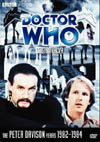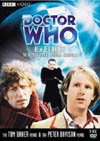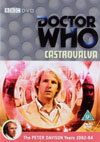DVD Extras include:
FIRST IMPRESSIONSUpon first viewing, this was only the fourth Doctor Who story I had ever seen, since poor TV reception forced me to take a hiatus after the first three Key to Time stories of season sixteen. I jumped in two minutes late and was immediately at a loss to figure out who anybody was. No Romana, no K9, no quest for powerful time objects. And everyone was calling some young blond guy the Doctor. What had happened to the Tom Baker Show?
"All Time-Lords regenerate, according to this data bank."What was a Time Lord? What did it mean when they regenerated? The script for Castrovalva offered no real explanations for the uninitiated.Obviously the Doctor was sick - that much was clear. Five days later, a re-transmission showed me the few opening minutes I'd missed, and I saw the Doctor I recognized transform into the young blond one. Yes, this strange metamorphosis disease must have been crafted to give Tom some time off, either because he was ill himself or needed a holiday. When the four episodes were up, the Doctor would get better, and Tom Baker would come back. That must be what it was. I didn't feel like I was watching one of the better Doctor Who stories. The initial action with the security guards had little gusto, backed by a musical cue that stuck out badly and produced an unfair prejudice in me against Paddy Kingsland that took quite some time to wear off. The opening sequence earns a lot of positive points though, not least through being the fastest paced portion of the story outside of episode four. Adric successfully makes the point that the Doctor and (most of) his current companions are not of Earth. The essentials of the TARDIS, and more, are laid out more clearly here than in practically any other story, and this is where it will be most important to do so: at the beginning of both a new season and a new Doctor's era. The relationship between the interior and exterior of the ship is made clear by the direct cut of the three characters traversing between them, and further emphasized by the views on the scanner screen. Nyssa is even allowed to set a precedent for what some of the controls do, putting some of the confused twiddling of previous eras to shame. Nice. Even better, a pillar materialized out of nowhere to a very satisfying sound effect, bringing an evil figure in a dark control room to the scene. Intriguing. My limited knowledge of the show had me thinking/hoping it was the Black Guardian finally showing his face and coming after the Doctor, or at least an agent of the Black Guardian. However, Adric and Nyssa both have lines that very quickly establish this character and a smidgeon of his recent history with the Doctor. This was the Master, he also had a TARDIS, and he happily used its power against people. As much as one might criticize the visual effects today, the blue and green energy waves coming from the Master's TARDIS were a much welcome rare sight on television back then, and I loved it. And the excellent demonstration of what TARDISes can do continued with some dematerializations and an example of "hover mode". Even then though, the jittering of the film background behind the video effect of the Master's TARDIS hovering was something I wished had been better done. As I was getting my first impressions of the three companions for the series, I found myself empathizing with Adric more than the others. Tegan and Nyssa seemed to natter excessively in this, mostly at a loss to understand what was going on or what to do. On the other hand, Adric, in this first episode, bravely creates the diversion at risk to himself, commands the confrontations with the antagonists, operates the TARDIS console with confidence and skill, and demonstrates that he knows what he is doing and just gets on with it. And in the Doctor's later speech about the companions' roles, his voice becomes both distant and reverent when he speaks of Adric. Very nice touch. Like many bright young teenage boys at the time, it became easy to imagine oneself in Adric's place, traveling with the Doctor and sharing his adventures. Perhaps I was lucky in getting my first impression of Adric from season nineteen, where he is better served, than season eighteen.
Peter Davison's DoctorThe companions pretty much own the opening action of the story. Only after things settle down do we get to explore the new Peter Davison Doctor. Davison does some impressions of William Hartnell and Patrick Troughton that are a delight to behold now that I've become a knowledgeable fan of the whole show. However, when I first saw it, I had no idea what it was all about, and was not very well impressed. Indeed, Davison's lines in the first two episodes are packed so full of old references to earlier eras and people, one almost guarantees it will go over most people's heads and be confusing. In my mind, this makes it harder to get into Davison's portrayal of the Doctor, because in essence, he is not yet showing it. The regeneration trauma getting in the way of him taking command of the adventure and becoming heroic, which is extended and lengthened in this story more than in most other Doctors' debuts, is also a huge disadvantage. While I might be tempted to introduce others to Doctor Who with this story, knowing how well it shows off the TARDIS and is the beginning of my favourite Doctor's era, I don't think it really shows the Doctor in a way that can capture new viewers and make them fans of the show.A lot of people, including Peter Davison himself, argue that he was too young for the role. I find this rather bizarre, when you consider what regeneration is supposed to be from a story and character point of view. Watch "Underworld" (story no. 96) again, which contains what is probably the best audio/visual explanation of the process, and you will see the point. The point is to extend length of life, and restore youth, energy, and vitality. Having a middle-aged-looking Doctor change into another middle-age-looking Doctor doesn't fulfill this need at all. Having an old Doctor transform into a young one is the essence of what it is all about. And really, this has only been achieved twice on the program: when William Hartnell gave way to Patrick Troughton, and when Peter Davison took over from Tom Baker. Which leads me to the trait that I loved most about Peter's Doctor and which seemed to symbolize his era best: he was an old man in a young body, wise beyond his apparent years. I later came to empathize with him through this trait more so than I ever did with Adric. It's a huge part of what made Peter a great Doctor. I think the show could gain a lot of realism if each Doctor was shown to be much older when they leave the show than when they first join, and if the tight immediacy of between-story-continuity was loosened to make it seem as if a hundred or more years passed during each Doctor's era. Will Peter Davison ever come back as the Doctor? I think that might be a great way to extend the show beyond the artificial limit of 13 lives for each Time Lord imposed by Robert Holmes in "The Deadly Assassin" (story no. 88), if after the 13th Doctor decides to leave, they explore a parallel line where "The Caves of Androzani" (story no. 136) and all that came after it had never happened, Peter Davison was still the Doctor, now the old man in a more senior man's body, and his adventures and those of his other eight future lives continue again. Davison himself still seems keen to have another crack at it, keen that he could bring more to it now than before. It would be just too sweet, I think. Then again, perhaps the fact that the Doctor is half human, a clever reason for his character being so different from most other Time Lords, and for him spending half of his adventures on Earth, might also spare him from the 13-life limitation. But enough digressing, let's get back to Castrovalva.....
Event OneThe early sequence surrounding Event One is great for a number of reasons. The concept itself is highly symbolic of the beginning of a new era for Peter's Doctor and the show as a whole. It's also a wonderfully spacey / unearthly setting emphasizing high technology and astronomy. Thirdly it contrasts the Doctor and the Master while showcasing each in their own "home" environments, demonstrating the time/space travel abilities of their TARDISes. It is just a pity that a lot of it became overly wordy, particularly in the sidetracks that Nyssa and Tegan get into. And the pace is often not very riveting.The pace finally reaches its slowest stretch for the final sequences of Part Two. While there is some entertainment value in the TARDIS's peculiar landing, a proper demonstration of materialization is sorely lacking and was a huge source of disappointment on first viewing. The end sequence is also very reminiscent of the "missing Doctor" episodes of the 1960's, with the companions taking over the task of keeping the story moving. On the plus side, Nyssa and Tegan don't have to waste time looking for the Doctor through most of this, but on the down side, the plot has no real advancement either throughout their trek through the forest. The location is very beautiful and successfully photographed - rarely does an alien planet turn out so well. There is a chance for good humour or character development during such a sequence, but this doesn't develop very interestingly either. Thankfully our musician takes the opportunity to step up and deliver the story's most memorable theme during this sequence, and while it has much merit on its own, it does nothing to relieve the slow pace pulling this story's ranking down. The town of Castrovalva turns out to be a huge design success, very interesting and decorative, and a joy to look at even before the premise of the story is made clear. The costumes and make-up are okay, both suitably alien and fitting in well with the architecture, but seem somehow too artificial for my tastes. The three main guest actors are all superb in their roles and work well together to paint a picture of the town's gentle social structure. Doctor Who veteran Michael Sheard gives a particularly wonderful performance, and made a very positive first impression on me when I first saw the show. Paddy Kingsland's score is tasteful for the most part and works quite well. Many of the cues are fantastic and even iconic, particularly the new bits surrounding regeneration, take-off, Event One, and the concluding action. The theme for the tapestry is also quite excellent. The sections attempting more upbeat action are less successful - the scrambling to escape Castrovalva being okay, while action on location ranges from bad (episode three sprinting) to awful (episode one's ambulance chase).
The Master's art of disguise rises to a new level with this story, and will remain at its height throughout Peter Davison's era. His motivations are far more simplistic here than what we've seen in the past - no particularly grand scheme, no real trouble for him to try to get out of. It's a simple case of revenge and trap-setting, which also serves as a test for an application of the technology he acquired in the last story. While this motivation might be less than all one could hope for, it still works very well by being a direct continuation of the previous two stories, where the Master had a lot more going on. The reason for his disguise also makes perfect sense. Anthony Ainley puts in a tremendously compelling performance, both in and out of disguise, and instantly made the Master into one of my favourite villains of all time. Excellent. The final sequence achieves some interesting and unexpected effects. The sound and visuals for the Master's Tissue Compression Eliminator never seem to be the same for any two stories, so it's not surprising that I find the ones used here in Castrovalva to be my definitive favourites. The production never did quite get a true "Escher-esque" effect for the architecture or the challenge of escaping Castrovalva, but they do achieve something else that works just as well for a bizarre space-time trap. And in the end, that's enough. It remains uniquely theirs. Kudos.
International Titles:Deutsch (German): "Castrovalva"Magyar (Hungarian): "Castrovalva"Français (French): (Castrovalva)Русский (Russian): "Кастровальва"This story has become available on DVD and VHS video. Single Story versions:
Comments on this article are welcome. You may contact the author from this page:
|
||||||||||||||||||||||||||||||










